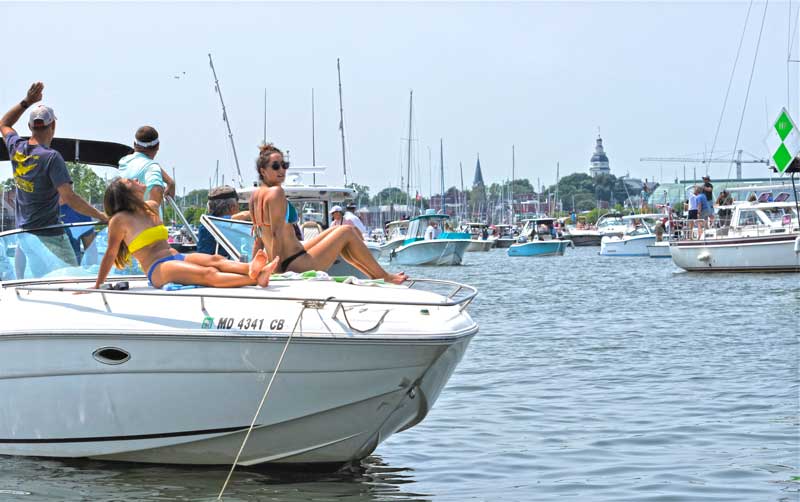You know it’s summertime on the Chesapeake when friends want to meet by boat, tie up, and spend time together for family fun in the shallows, boat drinks or dinner raftups, fishing, and fireworks show anchoring. Although gathering by boat can be a blast, the more boats that show up to tie together or anchor near one another, the more complicated it can be. Add in non-boating guests onboard, a sea breeze, or a storm, and things can get messy quickly. To prevent mishaps, plan ahead and keep the following anchoring and raftup tips in mind.

First of all, watch the weather. Windy days that kick up choppy seas and those with a high percentage of thunderstorms forecast pose challenges for rafting up with other boats. Calm summer days, of which we have many on the Chesapeake, are the best.
When rafting boats together at an anchorage, plan ahead and make sure your fenders and extra lines are ready before you arrive. It may help to call to the “mother ship,” which may be the first boat to arrive or the largest of your friends’ boats, to find out whether the crew wants you to come in on port or starboard.
If you have non-boating friends involved in the arrival and raftup (or anchoring) process, make sure to talk them through it before you get there. Once rafted up, before you settle in with a beverage, check that all the lines are secure and bumpers well-placed. If anchored, make sure the anchor is well set. This is particularly important if you expect the wind to build or a storm system to come in. If you know a storm is going to hit and you have time before it does, you may consider breaking up the raft to anchor on your own to avoid wear and tear on your boat.
When it comes to anchoring in a crowd at dusk and leaving in the dark, as we do during fireworks displays, here are 10 suggestions:
1. Pay attention to off-limits areas, such as the restricted zone around the Naval Academy seawall during the Annapolis fireworks show and the area near the barge in most shows. If no boats are anchored in a particular spot, there may be a reason for it.
2. Monitor your depth sounder, or if you don’t have one, bring a chart to monitor your depth.
3. Mooring and docking prices vary by town, so inquire before you go.
4. While your boat is at anchor, turn your running lights off and turn a single white anchor light on. As soon as the anchor comes up, the running lights should be on.
5. When in motion, turn your music down so as not to distract you or other boaters around you.
6. Use a spotlight sparingly and keep it aimed low. Avoid shining it directly at other boat operators as it can temporarily blind them.
7. Try not to anchor too close to other boats; keep at least three boat-lengths’ distance. Make sure to let out enough line (scope) to ensure your anchor will hold. Dragging anchor during a fireworks show can become a tangled mess.
8. Kids and poor swimmers should wear a lifejacket at all times. If you’re killing time before the fireworks show and kids are jumping off your boat, keep an eye on them and don’t let them swim far, especially with so many moving vessels in the area.
9. Give commercial vessels, such as water taxis and tour boats, room to maneuver.
10. Use common sense and courtesy: avoid collisions, keep your speed down, and have a non-drinking designated operator at the helm.